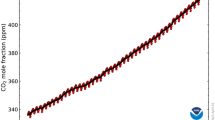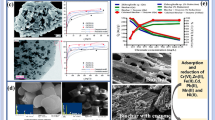Abstract
High concentrations of soluble Mn in electrolytic manganese solid waste (EMSW) in soil cause the severe contamination in China. Calcium oxide and magnesium oxide-dominated stabilizers are suitable for the solidification/stabilization (s/s) of EMSW. However, the long-term performance of s/s using those two types of stabilizer is problematic. The aim of this study was to develop an accelerated aging method to simulate the long-term natural carbonation of solidified/stabilized EMSW. The joint use of accelerated carbonation, leaching test, mineralogical analysis, and microstructural observation was applied to assess the long-term performance of the s/s EMSW system. On an accelerated carbonation test for solidified/stabilized EMSW, an increase in Mn leaching from 13.6 to 408 mg/kg and a 1.5–2.3 decrease in pH was achieved by using CaO-dominated stabilizers, while an increase in manganese (Mn) from 30 to 266 mg/kg and a decrease in pH of 0.17–0.68 was seen using MgO-dominated stabilizers. CaO+Na3PO4 and CaO+CaCO3 were exceptions in that the leaching value of soluble Mn was lower after carbonation. Mineralogical analysis showed that rhodochrosite in the carbonated s/s system was generated not only from the reduction of hausmannite but also from the reversible reaction between Mn(OH)2 and MnCO3. Carbonation destroyed the tight particle structure resulting in a porous and loose structure. As for s/s EMSW treated by MgO-dominated stabilizers, carbonation affected the agglomerating structure and mineralogical composition by increasing magnesium (Mg) migration, thereby forming hydromagnesite that had weak binding ability and a nested porous shape. Therefore, carbonation by itself does not cause deterioration to s/s products of the soluble Mn but does have significant effects on the microstructure and mineralogical composition. It is recommended to add Na3PO4 or CaCO3 into a single CaO stabilized EMSW system to prevent aging of the system, allow formation of Mn phosphate precipitates, and improve the absorption and oxidation of soluble Mn(II).







Similar content being viewed by others
References
Arickx S, Van Gerven T, Vandecasteele C (2006) Accelerated carbonation for treatment of MSWI bottom ash. J Hazard Mater 137:235–243
Arm M, Suer P, Arvidsson H, Lindqvist J-E (2011) Technical and environmental long-term properties of industrial residues—summary of field and laboratory investigations. Waste Manag 31:101–107
Baciocchi R, Costa G, Di Bartolomeo E, Polettini A, Pomi R (2009) The effects of accelerated carbonation on CO2 uptake and metal release from incineration APC residues. Waste Manag 29:2994–3003
Baciocchi R, Costa G, Lategano E, Marini C, Polettini A, Pomi R, Postorino P, Rocca S (2010) Accelerated carbonation of different size fractions of bottom ash from RDF incineration. Waste Manag 30:1310–1317
Birkner N, Navrotsky A (2012) Thermodynamics of manganese oxides: effects of particle size and hydration on oxidation-reduction equilibria among hausmannite, bixbyite, and pyrolusite. Am Mineral 97:1291–1298
Boyle F, Lindsay W (1986) Manganese phosphate equilibrium relationships in soils. Soil Sci Soc Am J 50:588–593
Chimenos J, Fernandez A, Nadal R, Espiell F (2000) Short-term natural weathering of MSWI bottom ash. J Hazard Mater 79:287–299
Diener S, Andreas L, Herrmann I, Ecke H, Lagerkvist A (2010) Accelerated carbonation of steel slags in a landfill cover construction. Waste Manag 30:132–139
Du B, Hou D, Duan N, Zhou C, Wang J, Dan Z (2015) Immobilization of high concentrations of soluble Mn (II) from electrolytic manganese solid waste using inorganic chemicals. Environ Sci Pollut Res 22:7782–7793
Duan N, Wang F, Zhou C, Zhu C, Yu H (2010) Analysis of pollution materials generated from electrolytic manganese industies in China. Resour Conserv Recycl 54:506–511
Duan N, Dan Z, Wang F, Pan C, Zhou C, Jiang L (2011) Electrolytic manganese metal industry experience based China's new model for cleaner production promotion. J Clean Prod 19:2082–2087
Fernandez Bertos M, Simons S, Hills C, Carey P (2004) A review of accelerated carbonation technology in the treatment of cement-based materials and sequestration of CO2. J Hazard Mater 112:193–205
Fernandez A, Chimenos J, Segarra M, Fernandez M, Espiell F (1999) Kinetic study of carbonation of MgO slurries. Hydrometallurgy 53:155–167
Gunning PJ, Hills CD, Carey PJ (2010) Accelerated carbonation treatment of industrial wastes. Waste Manag 30:1081–1090
Gurtubay L, Gallastegui G, Elias A, Rojo N, Barona A (2014) Accelerated ageing of an EAF black slag by carbonation and percolation for long-term behaviour assessment. J Environ Manag 140:45–50
Jauregui MA, Reisenauer H (1982) Calcium carbonate and manganese dioxide as regulators of available manganese and iron. Soil Sci 134:105–110
Johannesson B, Utgenannt P (2001) Microstructural changes caused by carbonation of cement mortar. Cem Concr Res 31:925–931
Li X, Bertos MF, Hills CD, Carey PJ, Simon S (2007) Accelerated carbonation of municipal solid waste incineration fly ashes. Waste Manag 27:1200–1206
Liska M, Al-Tabbaa A (2009): Ultra-green construction: reactive magnesia masonry products, Proceedings of the Institution of Civil Engineers-Waste and Resource Management. Thomas Telford Ltd, pp. 185–196
Liu L, Ha J, Hashida T, Teramura S (2001) Development of a CO2 solidification method for recycling autoclaved lightweight concrete waste. J Mater Sci Lett 20:1791–1794
Mauric A, Lottermoser BG (2011) Phosphate amendment of metalliferous waste rocks, century Pb–Zn mine, Australia: laboratory and field trials. Appl Geochem 26:45–56
Mo L, Panesar DK (2012) Effects of accelerated carbonation on the microstructure of Portland cement pastes containing reactive MgO. Cem Concr Res 42:769–777
Morgan JJ (2005) Kinetics of reaction between O2 and Mn(II) species in aqueous solutions. Geochim Cosmochim Acta 69:35–48
Polettini A, Pomi R (2004) The leaching behavior of incinerator bottom ash as affected by accelerated ageing. J Hazard Mater 113:209–215
Polettini A, Pomi R, Lo Mastro S, Piantone P (2003) Accelerated ageing of incinerator bottom ash as a tool for landfill management optimization, proceedings of the 5th international waste management and landfill symposium. Sardinia, Italy
Radha A, Navrotsky A (2014) Manganese carbonate formation from amorphous and nanocrystalline precursors: thermodynamics and geochemical relevance. Am Mineral 99:1063–1070
Rötting TS, Ayora C, Carrera J (2008) Improved passive treatment of high Zn and Mn concentrations using caustic magnesia (MgO): particle size effects. Environ. Sci. Technol. 42:9370–9377
Santos RM, Mertens G, Salman M, Cizer Ö, Van Gerven T (2013) Comparative study of ageing, heat treatment and accelerated carbonation for stabilization of municipal solid waste incineration bottom ash in view of reducing regulated heavy metal/metalloid leaching. J Environ Manag 128:807–821
Valls S, Vazquez E (2001) Accelerated carbonatation of sewage sludge–cement–sand mortars and its environmental impact. Cem Concr Res 31:1271–1276
Van Gerven T, Moors J, Dutre V, Vandecasteele C (2004) Effect of CO2 on leaching from a cement-stabilized MSWI fly ash. Cem Concr Res 34:1103–1109
Walton JC, Bin-Shafique S, Smith RW, Gutierrez N, Tarquin A (1997) Role of carbonation in transient leaching of cementitious wasteforms. Environ Sci Technol 31:2345–2349
Xin B, Chen B, Duan N, Zhou C (2011) Extraction of manganese from electrolytic manganese residue by bioleaching. Bioresour Technol 102:1683–1687
Xu F, Jiang L, Dan Z, Gao X, Duan N, Han G, Zhu H (2014) Water balance analysis and wastewater recycling investigation in electrolytic manganese industry of China—a case study. Hydrometallurgy 149:12–22
Yi Y, Liska M, Unluer C, Al-Tabbaa A (2013) Carbonating magnesia for soil stabilization. Can Geotech J 50:899–905
Zhang Z, Guo G, Teng Y, Wang J, Rhee JS, Wang S, Li F (2015) Screening and assessment of solidification/stabilization amendments suitable for soils of lead-acid battery contaminated site. J Hazard Mater 288:140–146
Acknowledgments
The authors would like to gratefully acknowledge the National Key Project of Scientific and Technical Supporting Programs by the Ministry of Science & Technology of China (Grant No. 2012BAF03B03), the National Science Foundation of China (Grant No. 21506199), and fundamental research funds in central public welfare research in institutes of Chinese Research Academy of Environmental Sciences.
Author information
Authors and Affiliations
Corresponding author
Additional information
Responsible editor: Philippe Garrigues
Rights and permissions
About this article
Cite this article
Du, B., Zhou, C., Dan, Z. et al. Aging of solidified/stabilized electrolytic manganese solid waste with accelerated carbonation and aging inhibition. Environ Sci Pollut Res 23, 24195–24204 (2016). https://doi.org/10.1007/s11356-016-7635-8
Received:
Accepted:
Published:
Issue Date:
DOI: https://doi.org/10.1007/s11356-016-7635-8




